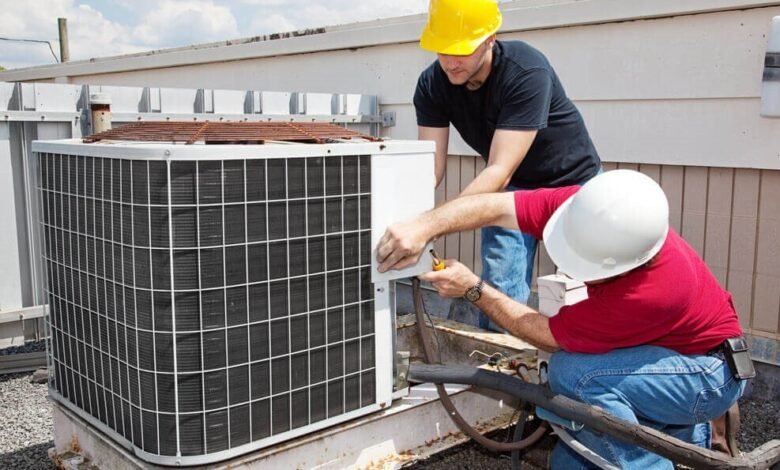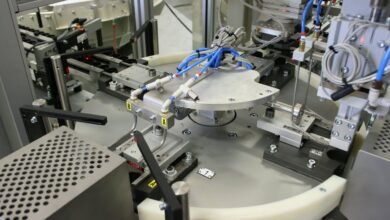Functions and Roles of Components in Split AC Systems

1. Understanding the Role of Refrigerant in Air Conditioning
Functions and Roles of Components in Split AC Systems – Air conditioning (AC) systems play a crucial role in providing comfort by regulating indoor temperatures. One key component that enables the cooling process is the refrigerant. In this article, we will delve into the significance and functions of refrigerants in air conditioning systems.
The Basics of Refrigerants:
Refrigerants are substances that undergo a phase change from gas to liquid and back again at low temperatures. They are responsible for absorbing and releasing heat, facilitating the cooling cycle within an AC system. Refrigerants frequently employed in air conditioning systems encompass hydrofluorocarbons (HFCs), hydrochlorofluorocarbons (HCFCs), and hydrocarbons.
Heat Absorption and Release:
The refrigerant starts its journey in the evaporator coil, located in the indoor unit. In this phase, it absorbs heat from the indoor air, causing the refrigerant to evaporate and transform into a low-pressure gas. The warm air inside is thus cooled down, creating a more comfortable indoor environment.
Next, the low-pressure gas is compressed by the compressor, transforming it into a high-pressure, high-temperature gas. This gas then flows to the condenser coil located in the outdoor unit. In the condenser, the refrigerant releases the absorbed heat to the external environment, causing it to condense back into a liquid.
The Expansion Process:
After the heat release, the refrigerant enters the expansion valve, where its pressure is reduced, and it undergoes expansion. This process prepares the refrigerant to re-enter the evaporator coil to absorb more heat and continue the cycle.
Environmental Considerations:
Over the years, concerns about the environmental impact of certain refrigerants have led to the development and adoption of more environmentally friendly options. The phase-out of ozone-depleting substances, such as chlorofluorocarbons (CFCs), has been a significant step towards sustainable air conditioning practices.
Conclusion:
In conclusion, the role of refrigerants in air conditioning systems is indispensable. They enable the absorption and release of heat, making it possible to maintain comfortable indoor temperatures. With ongoing advancements in refrigerant technology, the air conditioning industry continues to strive for solutions that are both effective and environmentally conscious. Understanding the functions of refrigerants provides insight into the intricate workings of AC systems and the importance of responsible choices in maintaining a balance between comfort and sustainability.
2. Understanding the Role of Expansion Valve in Air Conditioning
The air conditioning (AC) system is a complex network of components working together to regulate indoor temperature. Among these components, the expansion valve plays a crucial role in the cooling process. In this article, we will delve into the functions and significance of the expansion valve in air conditioning systems.
The Basics of Air Conditioning:
Before exploring the expansion valve’s role, it’s essential to understand the basic principles of how an AC system operates. AC systems work on the principle of heat transfer, utilizing a refrigerant to absorb heat from indoor air and release it outdoors. This cycle involves the refrigerant transitioning between a gaseous and liquid state.
The Role of the Expansion Valve:
The expansion valve, also known as the metering device, is a small but pivotal component in the AC system. Positioned between the condenser and evaporator coils, the expansion valve regulates the flow of refrigerant, controlling its pressure and temperature.
- Pressure Reduction:
The primary function of the expansion valve is to reduce the high-pressure liquid refrigerant from the condenser to a low-pressure, low-temperature state before entering the evaporator coil. This reduction in pressure allows the refrigerant to absorb heat efficiently from the indoor air. - Temperature Control:
By controlling the flow of refrigerant, the expansion valve ensures a precise and controlled release into the evaporator coil. This controlled release is vital for achieving the desired temperature inside the living or working space. - Efficient Heat Exchange:
The expansion valve’s role in regulating refrigerant flow contributes to the efficient heat exchange process. As the refrigerant expands, it absorbs heat from the surrounding air in the evaporator coil, resulting in the cooling effect that is felt indoors. - Preventing Frost Formation:
Another critical function of the expansion valve is to prevent the formation of frost or ice on the evaporator coil. It maintains the optimal conditions for heat absorption without allowing the refrigerant to freeze.
In summary, the expansion valve is a fundamental component in the air conditioning system, playing a vital role in regulating the flow, pressure, and temperature of the refrigerant. Understanding its functions helps users appreciate the intricacies of AC systems and highlights the importance of regular maintenance to ensure optimal performance. The next time you experience the cooling comfort of your AC, remember the unsung hero – the expansion valve – working behind the scenes to keep you cool and comfortable.
3. Understanding the Role of Air Handler in Air Conditioning
Air conditioning systems play a crucial role in maintaining a comfortable indoor environment, and one key component that contributes significantly to their functionality is the air handler. In this article, we will delve into the importance and functions of the air handler in air conditioning systems.
What is an Air Handler?
An air handler is a vital part of a split-type air conditioning system, typically located inside the building. Its primary function is to regulate and circulate conditioned air throughout the living or working space. The air handler consists of various components that work together seamlessly to ensure efficient cooling and distribution of air.
Components of an Air Handler:
- Evaporator Coil: The evaporator coil is responsible for absorbing heat from the indoor air. It contains a refrigerant that evaporates to cool the air passing over it.
- Blower Fan: The blower fan is responsible for moving the conditioned air through the ductwork and into the living spaces. It ensures a consistent and comfortable airflow.
- Filter: The air handler includes a filter that traps dust, dirt, and other particles, ensuring that the circulated air is clean and free from contaminants.
- Dampers: These are adjustable plates within the air handler that control the amount of air flowing through the system. They help in maintaining the desired temperature and airflow.
Functions of the Air Handler:
1. Air Circulation: The primary role of the air handler is to circulate conditioned air throughout the building. This ensures that every room receives an adequate amount of cooled air, creating a consistent and comfortable indoor environment.
2. Temperature Regulation: The air handler plays a crucial role in regulating the temperature by controlling the operation of the evaporator coil. It helps maintain the desired cooling level set by the thermostat.
3. Humidity Control: In addition to temperature regulation, the air handler also aids in controlling humidity levels. As the evaporator coil cools the air, it removes excess moisture, contributing to a more comfortable atmosphere.
4. Air Filtration: The air handler’s filter is essential for trapping particles and contaminants present in the air. This not only improves indoor air quality but also ensures the proper functioning of the air conditioning system by preventing dirt buildup on components.
Conclusion:
Understanding the role of the air handler in air conditioning systems is crucial for homeowners and businesses seeking efficient and reliable cooling solutions. By maintaining proper operation and regular maintenance of the air handler, individuals can enjoy a comfortable and healthy indoor environment year-round.
posting by: ac murah jakarta



